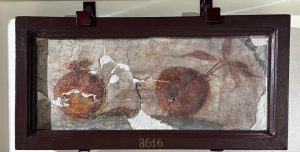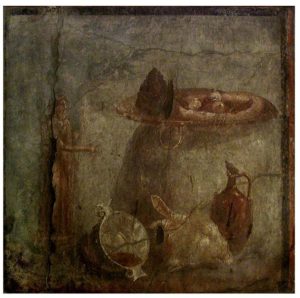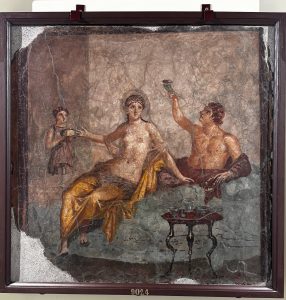STILL LIFE WITH FRUIT

This still life, now part of the collection at the National Archaeological Museum of Naples, depicts a pomegranate and a peach with a stem and four leaves, arranged on a horizontal surface subtly suggested by a green band. The primary function of this small painting appears to be purely decorative, as evidenced by the widespread presence of such artworks in Roman domus, where they adorned rooms of various types, often in the form of small, stylized panels. It can be classified within the genre of xenia (wall paintings of food items and products, named after the gifts of fresh food that hosts would send to guests in their rooms). Together with mythological scenes, these paintings helped envelop the viewer in an atmosphere of well-being and culture, in a society where refined gastronomy was an expression of social status.
SACRED OFFERING

The small painting, housed in the National Archaeological Museum of Naples, comes from the House of the Deer, one of the most lavish domus in Herculaneum. It was part of a series of seven panels that decorated the oecus, a room intended for leisure and guests. It depicts a statuette of Dionysus, wrapped in a long robe and holding a thyrsus in his left hand, while with his right arm he raises a kantharos (a cup used for drinking wine). At his feet, on a reddish ground, are arranged votive elements: an olive branch, an overturned silver kantharos with wine residue, the severed head of a young goat, and a bronze jug with a trilobed mouth. Behind the statue is a bronze tray with movable handles, on which are placed a pine cone and a terracotta bowl filled with figs and dates—symbols of ritual offering. The composition is designed to transform the secular and gastronomic value of food into a votive offering to the deity, a recurring theme in Herculaneum’s art, where the representation of food takes on religious and symbolic meaning.
BANQUETER AND HETAIRA

This refined panel painting, now housed in the National Archaeological Museum of Naples, depicts a banquet scene featuring a young man, reclining on a triclinium couch, in the act of raising a rhyton (a drinking vessel shaped like an ox horn) from which wine pours—a symbol of conviviality and pleasure. Beside him sits a female figure, most likely a courtesan (hetaira), gracefully posed and wrapped in a heavy drapery that covers her legs, while a veil gently brushes her shoulders and arms, enhancing her sensual allure. She is approached by a maidservant, shown in the act of offering her a casket, possibly containing jewelry or perfumes. In the foreground, a tripod table, likely made of wood and adorned with leonine paw feet, dominates the scene—an evident testament to the refined craftsmanship of the time. Upon it are arranged elegant glass tableware, adding further richness to the composition.
